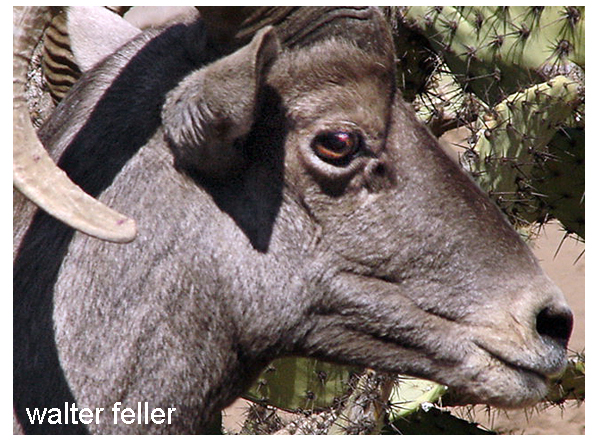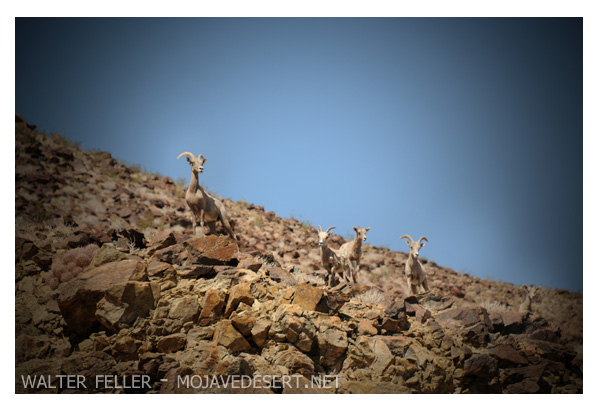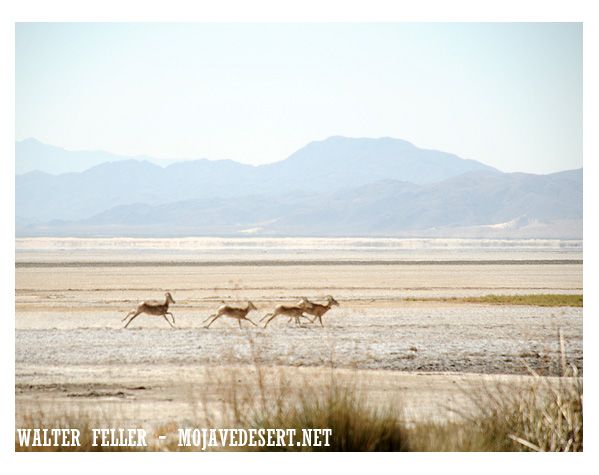Denizens
The Desert Bighorn and near Relatives
(Ovis nelsoni)In the most inaccessible canons, and on the rugged, barren, and desolate heights of those isolated mountains of mystic solitude which thrust their serrated pinnacles and roughened shoulders upward from the level of the desert plains, dwells the largest and most majestic of desert animals, the desert bighorn. It seems strange that this near cousin of our Rocky Mountain bighorn should find conditions congenial to his tastes in an almost waterless land whose summers exhibit an unusual number of days whose temperature reaches a hundred degrees or more. But he is the hardy frontiersman of his race, enjoying, like our Western settlers and adventurers of the early days, the buffetings of the stern elements and the freedom of the wild places. Among all his kinsmen, it is he that has ventured farthest southwest from the original ancestral home in the elevated plateaus and mountains of Turkestan.

The male desert bighorn, with his stocky body, noble, splendidly poised head, and massive, gracefully curled horns, is a picture of animal vigor. There is an appearance of natural composure and dignity about him that must compel the attention of the most disinterested observer. He is somewhat smaller in size and paler in color than the Rocky Mountain bighorn, but a no less imposing creature. A fullgrown individual is as large as a third-grown heifer, and may measure close to sixty inches from point of nose to tip of tail. As is usual among wild sheep, the female is smaller than the ram and the horns are much reduced. Stephens gives the average weights of an adult male and female Nelson bighorn as two hundred and fifty and one hundred and fifty pounds respectively.
Few animals support a head as heavy in proportion to the size of the body. A head and neck I have before me as I write weighed forty pounds when taken. The cores of the great horns are made of almost solid bone, and these add greatly, of course, to the weight of the rigidly built skull. Imagine if you can the nature of the impact of such a battering organ when driven forward by the strong body engine. Is it strange that in the battles which take place for the possession of the ewes necks are broken and lives exacted?
The growth of the horns of wild sheep is a curious phenomenon which has attracted the interest of naturalists for many years. The bony vascular core borne on the frontal bone is permanent, but its'* covering is renewed from time to time by the growth of a new sheath of cornified epidermis. This new cone of horny tissue is formed on the surface of the bony core, and as it thickens, the growth of the preceding season is pushed outward toward the end of the horn. Since the horn-sheath is not shed at any regular time, but slowly splits off and wears away through contact with the brush and rocks (the oldest always going first), there is found at any time the remains of many seasons' horn production, each marked by a ring showing where the cornified growth of the preceding season broke loose at the root as it was pushed outward toward the apex of the horn. Desert sheep are rarely to be found without broken horns. This, according to one authority, is due to the fact that they use them in seasons to drought for prying among the rocks and boulders in search of certain succulent bulbs which serve them as thirst-quenchers until the springs are replenished and flow again.

Flocks of bighorns must of necessity occupy pretty well-defined areas contiguous to the infrequently found water-holes and springs. They generally come to the tinajas or tanks to drink in the late afternoon or evening. The waters of the smaller springs are often heavily impregnated with mineral salts, but that found in the tanks — as the natural reservoirs of the desert caiions are called — is pure and delicious, the supply being renewed by every rain. These deep, rocky, gravel-filled basins are nearly always located just below some high "dry fall," and the sheep must often approach them over steep, tortuous paths. This is a decided advantage to them, as it gives them an opportunity to note the presence of enemies before descending for water.
There are no definite migrations among bighorns except the vertical ones. At the approach of winter the sheep living in the higher mountain ranges, such as the Funeral, Santa Rosa, and Providence Mountains, descend to the lower rocky foothills and mesas adjacent to the desert plains to feed on the galetta grass; but they go no farther. They know better than to abandon rough grounds, for it is only on such surfaces that they are able adequately to protect themselves and their young from the persecutions of coyotes and man. Sheep have been known to cross the open desert, but, as Dr. Meams observed, they are probably at such times passing from one mountain range to another.

When spring arrives the flocks work upward to the zone just below the pinons. At this season and during the summer the tender twigs of teamster's tea (Ephedra) and the new leaves of the buckthorn, rhus, and other shrubs are eaten in preference to grass. When I questioned the Indians concerning the summer food of the desert sheep, they almost invariably told me that the bighorns then ate many barrel cactuses, breaking them open with their horns. This I can readily believe, for I have often seen evidences of their banquets in the kitchen middens about the bases of the mutilated cactuses.
The single young is brought forth in March. By this time the ewes have retired to places of seclusion, selected because of their inaccessibility to predacious animals. The mothers with their young are always exceedingly alert, watchful, and sagacious, and from their favored positions they can easily detect the oncoming of a gunman or other enemy. When approached they may allow their impelling curiosity to hold them for a while, but at the proper time they quietly drop over the edge of the prominences which they have been occupying and by the time the pursuer has reached their former post they are far out of sight. They are very active and sure-footed animals, their capacity for exertion is almost illimitable, and on such occasions they do not hesitate to descend by seemingly impossible leaps to the shelf-like ledges far down the steep walls of the slotlike gorges of their mountain home. The lambs are able to follow their parents down the steepest cliffs without the least difficulty. To pursue the sheep to such dizzy positions is almost impossible or too laborious and hazardous for the most brave-hearted gunmen.
There is something incredible in the story that bighorns in jumping over cliffs alight on their horns, and those who have really become acquainted with these animals in their wild home will not venture to tell such tales about them. In fact, such persons are emphatic in their denials of such foolish and fanciful statements.
Almost incessant hunting by Indians, prospectors, and lawless professional hunters has so reduced the original bands of desert sheep that few large flocks remain. The automobile has now enabled the undiscriminating city hunters to get back into remote mountain ranges where until lately the sheep had at least some immunity from molestation because of their isolation. The hunters who go into the desert by automobile are too often unwilling to hunt in real sportsmanlike manner, and they resort to the most miserable and contemptible means for bringing in their game. Having supplied themselves with plenty of ammunition (generally enough, as one old-timer said, to kill all the sheep between Death Valley and the Mexican border), tobacco, and grub, they locate a water-hole to which the sheep are accustomed to resort, and then wait for the sheep to come in to drink. Often they care nothing for the age or sex of the animals, and an indiscriminate slaughter of the young and females through many seasons is bringing its sure result— a gradual extinction of one of our noblest desert animals. It is remarkable that the sheep have held their own as well as they have.